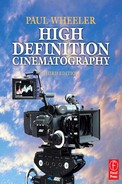The Sony F23 and F35
39.1 Some Background
At the time of writing, the F23 has been around a relatively short time and details of the F35 were only released very recently. As far as I could discern, hardly any F23s had made it to the UK and no F35s; these cameras are therefore two of only three I review here that I have not actually handled. Nevertheless, it is relatively easy to work out what they do from Sony-released information and their remarkable similarity to the Panavision Genesis. Indeed, it seems almost certain that they are the result of the Joint Venture agreements between Panavision and Sony and I am told that there was a mutual understanding that Sony would not release their versions until at least 2 years after Panavision had released the Genesis.
39.2 Basic Specifications
Both cameras share an almost identical body and both accept the Sony SRW-1 HDCAM-SR video tape recorder (VTR) mountable on top of the camera or on the rear of the camera body, again exactly as with the Genesis. Both cameras utilize a 14-bit analog-to-digital converter. The F35 has a variable frame rate from 1 to 50 frames per second and the F23 has preset steps of 23.98P, 24P, 29.97P, 50P, 59.94P, 50i and 59.94i.
The great difference between the two cameras lies right at the front of the camera bodies. The F23 has a hardened Sony B4 lens mount, behind which is Sony’s usual High Definition (HD) optical splitter block with three 2/3-inch image sensors, while the F35 has an Arriflex PL lens mount, behind which is a single charge-coupled device (CCD) sensor the same size as a motion picture Super 35 mm frame, which appears to be the same, or very similar, sensor to the one fitted to the Genesis.
Both the camera bodies are similar though not exactly the same as the Genesis, for Sony have built them to accept standard Arriflex 19 mm bars and film accessories, so all the follow focus devices and matte boxes familiar to film technicians who have used Arri cameras will fit and work in exactly the same way.
Both cameras, together with the VTR, will output and record a full 4:4:4 1920 by 1080 16 × 9 image.
Currently quoted prices suggest that the F23 will retail at around $150,000 and the F35 at around $250,000. Neither camera is therefore aimed at the economy end of the market.
39.3 Why Introduce These Cameras?
From where I sit in the UK, that is not at all an easy question to answer. The F23 echoes the 900R but offers an even higher bit rate and enhanced image manipulation, but I look forward to seeing who will want to spend that much money in order to process the output from most B4 mounted broadcast lenses. Maybe that is the answer: somewhere in the broadcast market there is the demand for such a high-end camera. Time will surely tell.
The F35, on the other hand, despite its cost, does look as if it might have a place in the world currently occupied mainly by 35 mm film. Two of the most popular high-end HD cameras, the Arriflex D-21 and the Panavision Genesis, can currently only be rented from their respective manufacturers and there may well be a lot of camera rental houses currently offering 35 mm film equipment who are looking for just such an HD camera body to extend their footprint in the market and this camera, with its complete compatibility with Arri accessories and the 35 mm lenses they will already have on the shelf, might look a very attractive way to go, particularly if it offers Genesis-type picture quality. This option could greatly open up the progress of HD across the film acquisition world.
